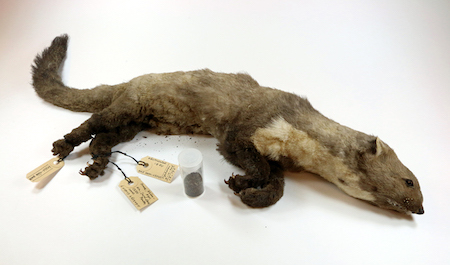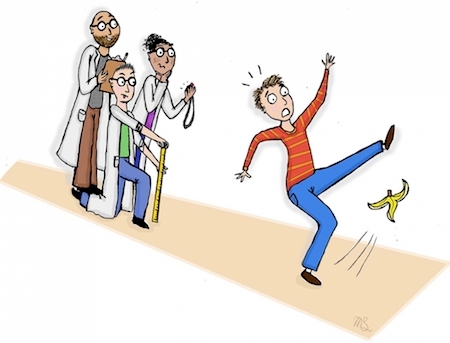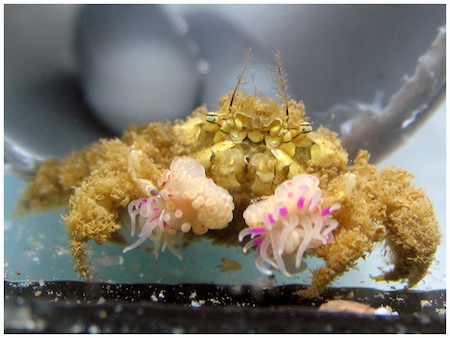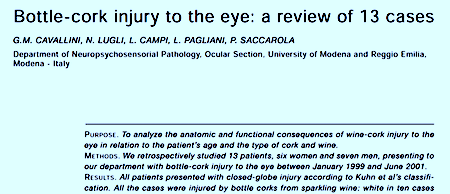Marc Abrahams's Blog, page 229
February 7, 2017
Animation of a man who methodically cracked his knuckles for 60 years


A Canadian Appreciation of the Canadian Ig Nobel Prize winners
Andrew Kidd, writing in The Varsity, give a happy nod to the many Canadian Ig Nobel Prize winners. His report begins:
Ig Nobels recognize hilarity in science
Seventeen Canadians have earned this ironic accolade
With more than seven million scientists exploring the world around us, it seems inevitable that some would stray from important scientific theories to the silly, the superfluous, and on rare occasions, the stupid.
For the last 26 years, Annals of Improbable Research, a scientific parody magazine, has awarded researchers with Ig Nobel Prizes, a pun referencing the acclaimed Nobel Prizes, to recognize the most ridiculous scientific work. The awards ceremony takes place at Harvard University — where scientists have won an impressive 49 Nobel Prizes — and recognizes “achievements that first make people laugh, then make [people] think.” The awards are often handed out by Nobel laureates.
Seventeen Canadians have won these somewhat humiliating prizes.
The 2015 Ig Nobel Prize in Physiology and Entomology was awarded to Canada’s Justin Schmidt, who “painstakingly” indexed the relative pain caused by different insect bites and precisely quantified the amount of misery of a bite.
U of T’s own Kang Lee won a Neuroscience Prize in 2014 for studying the brain activity of people who see Jesus in the burn patterns of toast….

February 6, 2017
Melanesian nose-flutes – did they ever exist?
Reports about the existence of nose flutes in Melanesia may have been greatly exaggerated. According to Univ.-Doz. Dr. Raymond Ammann of the Institutes für Musikwissenschaft, Leopold-Franzens-Universität Innsbruck (Department of Music, University of Innsbruck) who writes :
“[…] references to the existence of nose flutes in Melanesia are often based on unacknowledged references to earlier publications or on hearsay. The earliest references are the most suspect, especially because none of the authors states that he heard and saw the flute being played for more than just a few notes. From the many references on nose flutes in Melanesia, only a few seem to be of substance, especially those from Manus, but even there, the references are not unequivocal.”
The doctor points out that some artefacts described as ‘nose flutes’ can sometimes, in reality, be tobacco pipes. Or, in the case they are in fact flutes – they may have been mouth-blown rather than nose-blown.
“It should be observed that a musician might well sound a few notes with the nose when blowing his mouth-blown flute in order to show a European visitor his virtuosity when asked if he could play with the nose.”
And lastly, in the case that they truly are bona-fide nose flutes, they may not have come from Melanesia.
see: ‘Nose flutes in Melanesia, Facts or Fairytales’ [Caution: large file – very slow download] In: Oceanic Music Encounters, the Print Resource and the Humans Resource, Essays in Honour of Mervyn McLean. (Hg.) Richard Moyle. Research in Linguistics and Anthropology, Department of Anthropology, The University of Auckland, New Zealand, s. 3 – 14 [page 15 in the pdf]

February 4, 2017
The Big Bang, The Big Bang, and the Ig Nobel Prizes, in NYC on Super Bowl night
If you’re not watching the Super Bowl, and you happen to be in New York City, come to the 92nd Street Y, on Lexington Avenue at 92nd St., New York. The event starts at 8 pm, Sunday, February 5. Some TICKETS are still available.
You will see “Bang! Bang! The Big Bang Theory meets The Big Bang Theory”, a discussion of humor in science, with Claudia Dreifus (New York Times ace interviewer of scientists and other science-y people), Eric Kaplan (The Big Bang Theory TV comedy), Robert Wilson (Nobel laureate, co-discoverer of the cosmic microwave background), and Marc Abrahams (Ig Nobel Prizes, and author of the opera about the Big Bang; Bob Wilson performed in that opera).

Side Effects of Inversion Tables (tables that turn people upside-down)
A company called The Back Pain Relief Center looks (perhaps ruefully?) at some research on “Side Effects of Inversion Tables“.

February 2, 2017
Puppet Master: Possible Influence of Parasite Toxoplasma gondii on Managers and Employees
Is your boss easily distracted? Impulsive? With a diminishing IQ? It’s possible the he/she might be hosting the mind-altering parasite Toxoplasma gondii. Attention is drawn to this possibility in the latest online issue of the journal Academy of Management Perspectives.  An investigation by Petr Houdek, [pictured right] who is a director at the CEBEX experimental economics lab in Prague, outlines the possibilities, noting that it’s estimated that the parasite afflicts 30 to 40 percent of the worldwide human population – and that they may be chronically infected with T. gondii, which is known to be able to covertly alter cognition and personal characteristics in infected individuals.
An investigation by Petr Houdek, [pictured right] who is a director at the CEBEX experimental economics lab in Prague, outlines the possibilities, noting that it’s estimated that the parasite afflicts 30 to 40 percent of the worldwide human population – and that they may be chronically infected with T. gondii, which is known to be able to covertly alter cognition and personal characteristics in infected individuals.
“The article summarizes the parasite’s physiological mechanisms of affecting the host, important behavioral effects of the infection in humans and speculates on the possible impacts on skills and careers of employees and managers, organizational dynamics, inter-cultural management, and gender work roles.”
The author concludes by suggesting that :
“[…] Toxoplasma-positive individuals have specific personality characteristics compared to the non-infected population, and that such differences could be caused by physiological manipulation by the parasite, though in some cases there is still a probability that certain groups of people have a higher likelihood of getting infected. Toxoplasma-positive individuals have slower reaction times, they are more easily distracted and their working memory is worse. Toxoplasma may decrease an individual’s life satisfaction. Infected people more often believe that their instinctive behavior under imminent anger is rather slow and passive, and that some people have the power to impose their will on others. They also believe that when they are attacked, they stop fighting because their own sub-consciousness betrays them. Infected men have higher levels of testosterone and their physical appearance is portrayed as more masculine and dominant.”
See: Puppet Master: Possible Influence of Parasite Toxoplasma gondii on Managers and Employees which is currently awaiting publication in Academy of Management Perspectives.
Question [optional]: Could the same line of enquiry also be gainfully employed in political and/or leadership studies? [give current speculative examples where possible]
Also see: The work of Jaroslav Flegr, Jan Havlíček and Jitka Hanušova-Lindova, and to David Hanauer, Naren Ramakrishnan, Lisa Seyfried, who jointly shared the 2014 Ig Nobel Public Health Prize for investigating whether it is mentally hazardous for a human being to own a cat. (in the sense that cats can readily transmit the parasite to humans).

February 1, 2017
Boxer crab lifstyle: Hold anemonies in your claws, and make them reproduce
Boxer crabs almost constantly hold the fate — and the bodies — of sea anemones in their hands, so to speak. In their claws, really. There’s a new paper about this:
“Boxer crabs induce asexual reproduction of their associated sea anemones by splitting and intraspecific theft“, Yisrael Schnytzer, Yaniv Giman, Ilan Karplus, and Yair Achituv, PeerJ, epub January 31, 2017. The authors, in Israel, report:
“Crabs of the genus Lybia have the remarkable habit of holding a sea anemone in each of their claws. This partnership appears to be obligate, at least on the part of the crab. The present study focuses on Lybia leptochelis from the Red Sea holding anemones of the genus Alicia (family Aliciidae). These anemones have not been found free living, only in association with L. leptochelis. In an attempt to understand how the crabs acquire them, we conducted a series of behavioral experiments and molecular analyses. Laboratory observations showed that the removal of one anemone from a crab induces a “splitting” behavior, whereby the crab tears the remaining anemone into two similar parts, resulting in a complete anemone in each claw after regeneration.”
And that’s not all. There’s theft. There’s warfare. There’s all sorts of stuff. Details are in the study.
Mary Bates, writing for National Geographic, has further details, too, and some video.

Bottle-Cork in Your Eye (podcast #100)
What’s the damage from a sparkling-wine cork whanging into a merrymaker’s eye? A research study explores that very question, and we explore that study, in this week’s Improbable Research podcast.
SUBSCRIBE on Play.it, iTunes, or Spotify to get a new episode every week, free.
This week, Marc Abrahams discusses a published here’s-cork-in-your-eye study. Physicist Melissa Franklin lends her voice, and her scientific expertise, and her opinions —with dramatic readings from a research study you may have overlooked.
For more info about what we discuss this week, go explore:
“Bottle-Cork Injury to the Eye: A Review of 13 Cases,” G.M. Cavallini, N. Lugli, L. Campi, L. Pagliani L, and P. Saccarola, European Journal of Ophthalmology, vol. 13, no. 3, April 2003, pp. 287-91.
The mysterious John Schedler or the shadowy Bruce Petschek perhaps did the sound engineering this week.
The Improbable Research podcast is all about research that makes people LAUGH, then THINK — real research, about anything and everything, from everywhere —research that may be good or bad, important or trivial, valuable or worthless. CBS distributes it, on the CBS Play.it web site, and on iTunes and Spotify).

What the Frog’s Saliva Does for the Frog’s Tongue
Ig Nobel Prize winner David (“urination duration in mammals”) Hu and colleagues turned their intense gaze toward frog tongues and saliva. They published this study:
“Frogs use a viscoelastic tongue and non-Newtonian saliva to catch prey,” Alexis C. Noel, Hao-Yuan Guo, Mark Mandica, David L. Hu, Journal of the Royal Society Interface, 2017, 14, 20160764.
Frogs can capture insects, mice and even birds using only their tongue, with a speed and versatility unmatched in the world of synthetic materials. How can the frog tongue be so sticky? In this combined experimental and theoretical study, we perform a series of high-speed films, material tests on the tongue, and rheological tests of the frog saliva. We show that the tongue’s unique stickiness results from a combination of a soft, viscoelastic tongue coupled with non-Newtonian saliva. The tongue acts like a car’s shock absorber during insect capture, absorbing energy and so preventing separation from the insect. The shear-thinning saliva spreads over the insect during impact, grips it firmly during tongue retraction, and slides off during swallowing. This combination of properties gives the tongue 50 times greater work of adhesion than known synthetic polymer materials such as the sticky-hand toy. These principles may inspire the design of reversible adhesives for high-speed application.
The University of Georgia presents additional details, including this demo and explanation by study lead author Alexis Noel:
BONUS: From an earlier era, focusing higher in the frog’s skull, Jerry Lettvin‘s classic “What the Frog’s Eye Tells the Frog’s Brain“

January 31, 2017
“Animal Electrocuted at Atom Smasher Gets New ‘Life’ in Morbid Exhibit”
Mindy Weisberger reports, for LiveScience:
Deceased animals in a range of compromising poses share cautionary stories of times when wildlife interactions with humans turned deadly — for the wildlife — in the unusual exhibit “Dead Animal Tales” at the Natural History Museum Rotterdam (NHMR) in the Netherlands.
Recently, NHMR welcomed a new addition to the exhibit: a stone marten (Martes foina) that met its end Nov. 20, 2016, after it bumbled its way into a substation at the European Organization for Nuclear Research (CERN) in Geneva, Switzerland….

…Not many exhibits can say they began with homosexual duck necrophilia — but this one can. The specimen that launched “Dead Animal Tales” was a mallard that suffered a fatal collision with a window at the museum in 1995. Almost immediately afterward, another mallard approached and began having sex with the dead bird.
Exhibit curator and NHMR director Kees Moeliker wrote a study about the highly unusual behavior, which earned him the Ig Nobel Prize — an award for thoughtful research that also inspires laughter — in 2003.
“Thanks to the Ig Nobel Prize that my First-Case-of-Homosexual-Necrophilia-Paper won, the story of that poor bird became widely known and people wanted to see and admire the duck,” Moeliker told Live Science in an email….

Marc Abrahams's Blog
- Marc Abrahams's profile
- 14 followers









